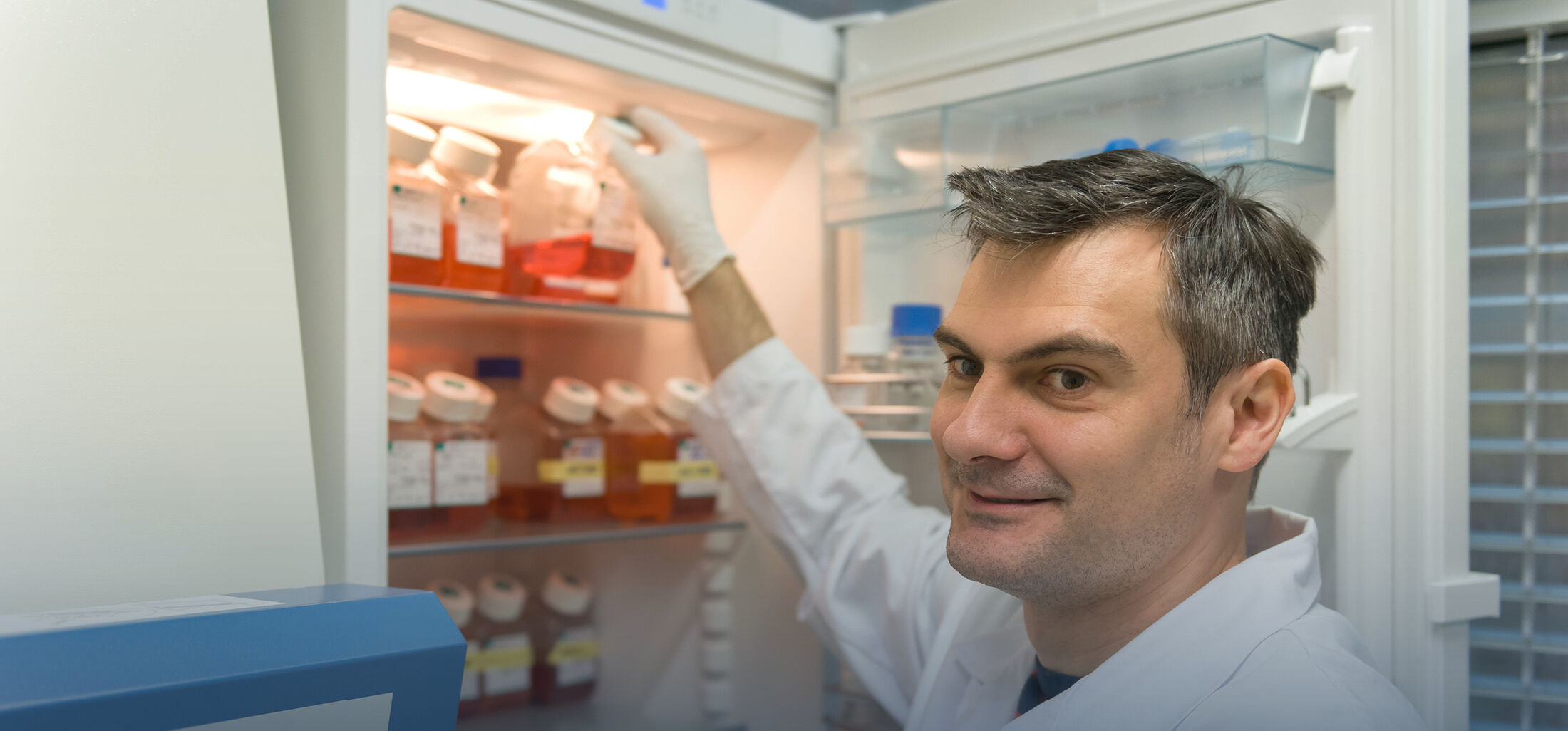Our research interests
Research at the Institute of Biochemistry and Molecular Immunology uses mast cells to address mechanisms of cellular reception and propagation of biological signals as well as the respective modulating factors. We study the regulated secretion of pro-inflammatory mediators (e.g. histamine, proteases, and cytokines) and address the question of which signaling pathways determine qualitative as well as quantitative aspects of cellular activation. Activation of mast cells plays a central role for the initiation and development of allergic diseases. This process is induced by multivalent antigens that cross-link IgE molecules which are bound to the high-affinity IgE receptor (FcεR1) on the surface of mast cells. Newly identified regulators of mast cell activation serve as potential targets for pharmacological intervention in allergic diseases. In this respect, we have identified the SH2-containing inositol 5-phosphatase, SHIP1, as a major gatekeeper of mast cell activation.
In recent years, additional roles (beneficial ones as well as detrimental ones) for mast cells have become obvious. For instance, mast cells protect from bacterial peritonitis, are involved in the development of certain autoimmune disorders (like arthritis and bullous pemphigoid), and contribute significantly to neurofibromatosis and atherosclerosis. Moreover, they are the main drivers of mastocytosis, a myeloproliferative neoplastic disease. Different receptor systems, like the receptor tyrosine kinase, c-Kit (CD117), and the Toll-like receptor 4 (TLR4 = receptor for lipopolysaccharide) are central for differential mast cell activity in health and disease. The analyses of respective signaling mechanisms represent research topics in our Institute.
The high-affinity receptor for IgE (FcεR1)
The FcεR1 on mast cells is a heterotetrameric receptor comprising an IgE-binding alpha subunit, and signal transducing beta and gamma subunits. The FcεR1 is activated by multivalent antigens that cross-link IgE-bound receptors. In contrast to many other receptors, such as growth factor receptors, the dose-response curve for FcεR1-mediated mast cell activation (e.g. degranulation and cytokine production) is bell-shaped. This suggests that depending on the antigen concentration the FcεR1 is capable of differentially regulating activation and crosstalk of signaling pathways. We identified SHIP1 as the critical negative regulator acting at high (= supra-optimal) antigen concentrations. Consistent with this, degranulation and cytokine production of SHIP1-deficient mast cells is not markedly reduced at supra-optimal antigen levels. Interestingly, SHIP1 was found to colocalize with the actin cytoskeleton (which has been shown previously to mediate the inhibition of degranulation at supra-optimal antigen doses). These results suggest that SHIP1, together with other negative regulators like protein kinase C (PKC)-δ and Lyn, restrains mast cell activation at supra-optimal antigen concentrations in concert with the actin cytoskeleton. A follow-up study in human basophils indicated that a comparable mechanism is functional in human FcεR1-expressing cells. Further studies into the signaling quality of the FcεR1 system activated by supra-optimal antigen concentrations revealed that pre-stimulation with stem cell factor (SCF) is able to release the antigen-mediated suppression and suggested a role for PKC-β in this process. The analysis of the intriguing dose dependency of the FcεR1 is ongoing in our laboratory.
The lipopolysaccharide (LPS) receptor, Toll-like receptor 4 (TLR4)
The detection of so-called pathogen-associated molecular patterns (PAMPs) by cells of the innate immune system is one of the pillars of the immunity against pathogens. PAMPs bind to Toll-like receptors (TLRs) and usually induce pro-inflammatory responses, for instance the production of the cytokines IL-6, TNF-α and IL-1β. One of the best studied TLRs is TLR4, the receptor for LPS (endotoxin) from gram-negative bacteria. LPS is a major recognition marker for the detection of gram-negative bacteria by the host and a powerful initiator of the inflammatory response to infection. TLR4-induced signal transduction and effector functions have been assessed mainly in monocytes/macrophages and the exciting knowledge gained from this cellular system is reviewed paradigmatically in journals and text books. Studying LPS-induced mast cell activation, we found prominent differences between mast cells and macrophages with respect to LPS recognition (receptor composition) as well as LPS-triggered signal transduction and effector functions (usage of different signaling pathways and differential usage of the same signaling molecules and pathways). This ongoing work emphasizes the importance to study signaling systems in different cell types and not to rely singly on information from the so-called cellular model system.
The Stem Cell Factor (SCF) receptor, c-Kit (CD117)
SCF is a pleiotropic cytokine, which acts on stem cells and precursor cells of all hematopoietic cell types. Whereas mature hematopoietic cells loose c-Kit expression, mature mast cells still express high levels of c-Kit. The SCF/c-Kit system is involved in many processes in mast cell biology, such as differentiation, proliferation, survival, chemotaxis, and production of pro-inflammatory mediators. Of importance, de-regulated c-Kit-mediated mast cell activation lies at the center of neoplastic diseases like mastocytosis and neurofibromatosis. We have identified SHIP1 and PKC- as important negative and positive regulators of c-Kit-mediated mast cell activation, respectively. Moreover, we could demonstrate positive as well as negative regulatory roles of the MEK-ERK pathway resulting in differential activation of transcription factors, such as Fos, Nr4a2, and KLF2. In addition, we aim to investigate the interplay between c-Kit and further mast cell receptors, e.g. FcR1, TLR4, and the adenosine receptors. Due to the involvement of c-Kit in neoplastic diseases, we are in the process of testing different pharmacological routes to suppress unwanted mast cell reactions. This research is ongoing and will stay an important topic in our Institute.


